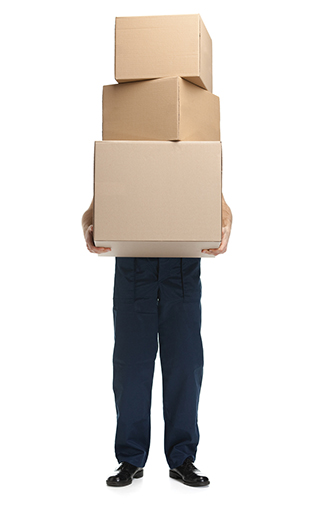
Even if a load isn’t too heavy for one person to carry, it is unwieldy if that person cannot see where he/she is walking.
10 steps to the perfect lift
SGIA recommends the following 10 steps to ensure the perfect lift:
- Plan ahead. Know what you are doing and where you are going and clear a path beforehand. This will help prevent you from making awkward motions when carrying a heavy load.
- Wear support. A belt designed to support your back will help you maintain a good lifting posture. Keep in mind, however, it will not enable you to lift a heavier weight!
- Balance your stance. A solid base of support is important, with feet shoulder width apart. Holding your feet too close together will cause instability, while holding them too far apart will hinder movement. It is okay to place one foot behind the load and the other next to it. Prepare to take short steps to maintain balance.
- Squat down. Standing on the balls of your feet (not the heels), get as close as possible to the load. Bend your knees and focus on keeping your spine straight. It can be useful to practise this lifting motion beforehand.
- Use your palms. Don’t just use your fingers to grip. Your palms will help ensure your grip will hold and not have to be switched while moving the load. Your grip will be stronger and more stable if you hold the load close to your body, rather than at the edge of your reach.
- Keep your posture. Tightening your abdominal muscles will keep your back in a good lifting position. Looking slightly upwards will also help maintain the proper spine position.
- Lift slowly and steadily. Use your legs and your abdominal and gluteal muscles to lift the load slowly, with no jerking movement. Your legs are many times stronger than your back muscles.
- Get help. As mentioned, if you are straining, the load is too heavy or the object is an awkward shape, get someone else to help you out. Before lifting the load with another person, make sure both of you have agreed on a path.
- Turn, don’t twist. When you need to change direction, point your feet where you want to go, then turn your whole body. Do not twist while you are carrying the load; always face the direction in which you are walking. If you need to turn, stop first, turn with small steps, then continue walking.
- Reverse the rules. When lowering a load and placing an object down, simply follow the same guidelines, but in the reverse order. If the load is not yet at its final destination, try to place it where there will be easy access for the next person.
With files from SGIA. For more information, visit www.sgia.org.





